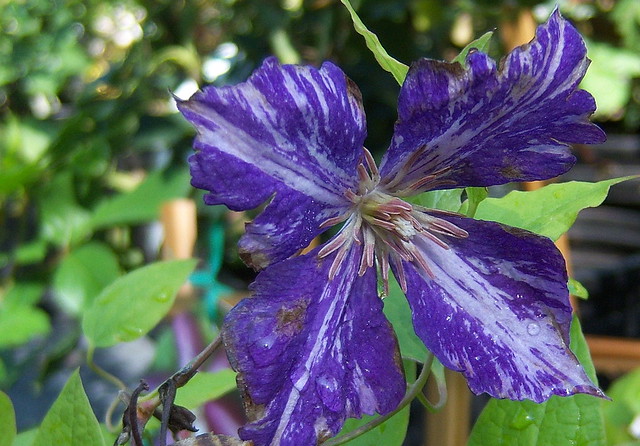Clematis 'Tie Dye'
Common Name: “Clematis”-Flower color may vary due to environment
 Clematis 'Tie Dye' is a new breakthrough in clematis coloring! I purchased this about 4 years ago from a great online site that is a candy land for plant geeks like me called Garden Crossing . When I saw the color, well I had to have one, and I must say the first year it was a dud, grew just a little, crossed it's arms, and just did not want to settle into our garden. But the following year arrived with a grand attitude. I planted it close to the deck, the roots remain cool but the vine can bask in the sun. So not only did I train this beauty on my deck but also on our bright lemon variegated hinoki cypress. What a statement it makes. I counted close to 50 blooms this year (4) and it stays in flower a good month or more starting in late June into July. 'Tie Dye' is very unusual and appropriately named! This is a one-of-a-kind, must have for the Four Season Garden.
Clematis 'Tie Dye' is a new breakthrough in clematis coloring! I purchased this about 4 years ago from a great online site that is a candy land for plant geeks like me called Garden Crossing . When I saw the color, well I had to have one, and I must say the first year it was a dud, grew just a little, crossed it's arms, and just did not want to settle into our garden. But the following year arrived with a grand attitude. I planted it close to the deck, the roots remain cool but the vine can bask in the sun. So not only did I train this beauty on my deck but also on our bright lemon variegated hinoki cypress. What a statement it makes. I counted close to 50 blooms this year (4) and it stays in flower a good month or more starting in late June into July. 'Tie Dye' is very unusual and appropriately named! This is a one-of-a-kind, must have for the Four Season Garden.
Planting- Clematis can live up to 50 years or more, pretty amazing. Take time to plant each one carefully. Water the pot well before planting. This is an important step for any planting. Once you have selected a location, dig a hole at least twice as big as the pot and twice as deep. In areas with poor drainage, Mix some of the soil from the hole with a good topsoil and compost , a good organic soil will help new roots to grow faster and healthier. 

 The exact proportions will vary by your soil conditions. Back fill some of the hole with this mix. Ease out the vine from its pot by first pushing up on the bottom of the pot . Never pull on the vine or its training stake to remove it. If it doesn't slide out easily, you may roll it gently one half turn on the ground while pushing down (be gentle) to loosen the sides of the soil from the pot. Clematis roots naturally run deep, so you will notice that most of the roots are in the lower half of the pot.
The exact proportions will vary by your soil conditions. Back fill some of the hole with this mix. Ease out the vine from its pot by first pushing up on the bottom of the pot . Never pull on the vine or its training stake to remove it. If it doesn't slide out easily, you may roll it gently one half turn on the ground while pushing down (be gentle) to loosen the sides of the soil from the pot. Clematis roots naturally run deep, so you will notice that most of the roots are in the lower half of the pot. The Simple Facts
- Late, Large Flowered Hybrid
- Full Sun, Partial Shade
- Zones 4-11
- Grows 10 to 12 feet
- Pruning: type 3
- Water regularly throughout the first growing season
So get your grove on, and put Clematis 'Tie Dye' on your "Must Have" list.







